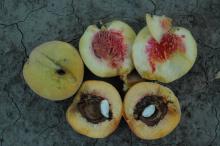Cause A physiological problem. The exact causes of pit breakage are unknown. Low temperatures and/or freeze damage during flowering and early fruit development may be factors. Fruit of most early peach cultivars enters the final swell of growth before the pit is completely hardened. As the fruit enlarges rapidly, stress exerted by the expanding flesh causes (or enhances) much of the pit fracturing. Because most early varieties are cling types, the strong attachment of flesh to pit probably enhances the forces exerted on the immature pit by the expanding flesh. Cultural practices that enhance fruit size (such as thinning, nitrogen application, girdling, and irrigation) usually increase the level of split pit. If freezes excessively reduce fruit loads, generally pit breakage increases. Excessive rain in the latter stages of fruit growth is another uncontrollable variable that aggravates pit breakage.
Symptoms The term "split pit" normally refers to the opening of the pit at the stem end of the fruit. This split becomes evident in the third stage of fruit growth, usually referred to as the final swell. Fruit generally develops rot problems much more quickly than sound fruit, and the risk is higher that disease will spread more rapidly from split-pit fruit to other fruit.
Cultural control
- Leave heavier crops on problem cultivars.
- Do not apply excessive nitrogen too close to harvest.
- Reduce or eliminate future plantings of the more troublesome cultivars.
Reference Tani, E., Polidoros, A.N., and Tsaftaris, A.S. 2007. Characterization and expression analysis of FRUITFULL-and SHATTER-PROOF-like genes from peach (Prunus persica) and their role in split-pit formation. Tree Physiology 27:649-659.


